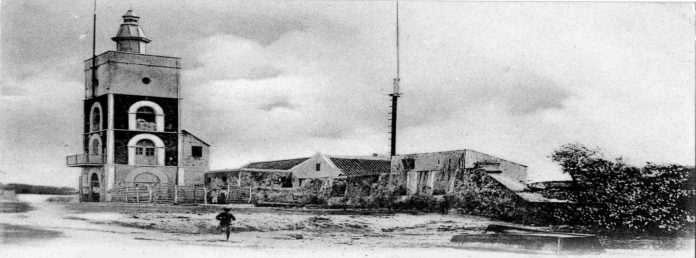Upon completion of Fort Zoutman in 1797, when there was no longer the tread and fear of unwanted visitors, white protestants at Ponton gradually started building their stone houses at the bay side located at a lower level. Ponton was airy and offered a strategic view over the South and West coast, but in those days without motorized transportation or a paved road, it was a bit too far from the site where ships entered. In 1797- we know this accurately- there was not a single house at the Paardebaai. Eight years later, therefore in 1805, there were as many as 32.

Pic. 1. The Dutch protestant church from 1846 .
Concerning the building of houses there must have been specific rules in effect, because according to the rules of the old art of building fortresses, there had to be between a fort and the nearest located building of the city an open space of not less than 800 paces, the so-called esplanade. A space that was needed to protect the city from the fort. The Minister of the Fort-church in Curacao in those years was the Rev. Gerard B. Bosch, who in 1823 visited our island and repeatedly came back here in the years thereafter. After his repatriation the Rev. Bosch wrote a book in Dutch, containing his memoirs, Travels in the West Indies and through part of South and North America, three volumes, in which he devotes much attention to Aruba. The findings by the Rev. Bosch in 1823 were, that Fort Zoutman satisfied all requirements and that there was an esplanade.
 Pic. 3. The Commanders house was standing where now Plaza Daniel Leo is downtown Oranjestad.
Pic. 3. The Commanders house was standing where now Plaza Daniel Leo is downtown Oranjestad.
Fort Zoutman Vice-Commander Jan van der Biest-the eldest son of Harmen, who had been commander from 1782 to 1791-was in charge of the Aruban administration. He continues in office as acting commander until, in 1821 Jacob Thielen I is appointed commander. Thielen who was descended from a family already residing in Curaçao in 1715, has been attached to the Curaçao court of Justice both as barrister and as secretary. He reported to the vice -commander on the 23rd of December 1821, and assumed office the first of January 1822, saluted by eleven guns.  Pic. 4. Guns of the fort
Pic. 4. Guns of the fort
In this period Aruba’s economic importance was not yet very considerable. Since it was defendant on decisions made in Curacao, which had some trade with Coro and Maracaibo in Venezuela. The return cargoes only consisted of goatskins, hide, and wood, which was stored on Aruba until there was a supply large enough to be shipped to Curaçao by schooner. Aruba was an intermediate station; just as Curacao itself was an intermediate station for what came from Europe and went to Aruba and vice versa. After 1816, however, an immediate decline was noticeable after British privateers’ harassments of Oranjestad, in spite of the fact that the disaffection of the Spanish colonies had caused a greater demand for supplies. This decline was mainly owing to the some-what drastic manner in which the naval forces of the combatants proceeded against Dutch shipping. In order to destroy the opponent’s trade international law was continually encroached upon, so that shipping was very seriously impeded. Privateers of the insurgents time and again ran into Aruban bays. Every now and then we hear about difficulties necessitating the intervention of Dutch warships.
 Pic. 5. A sky look over the bay area when many stone houses where build in a blink of an eye in the shadow of the frot.
Pic. 5. A sky look over the bay area when many stone houses where build in a blink of an eye in the shadow of the frot.
On 27 March 1817 His Dutch Majesty’s Daphne surprised in an Aruban bay the brigantine Indio Libre, which had come to anchor there with a prize, the Spanish schooner Nuestra Señora de la Candelaria. The commander of the Dutch brig of war ordered the privateer to relinquish his prize at once and to move out of the bay, with which the latter, after some delay, complied. His Dutch Majesty’s corvette Dolphijn in May 1819 encountered in one of our bays the independent privateer La Sozegada, also with a prize, and forcefully conducted both ships to Curacao. The Spanish privateer Centella even selected Aruba as operational base, lay at anchor there, and set sail as soon as a vessel hove in sight, to seize her and bring her into the privateer’s lair, the Dutch island of Aruba! Her captain even went so far as to hold a vessel that he had seized, the Twee Gezusters (Two Sisters), to ransom in the harbor of the island, and to rob goods from a ship lying in our roadstead, the Sally, which, having arrived here as a prize of another privateer, had been detained by the colonial administration.
Under Thielen these difficulties continued.
Discover an Aruba which no other could share with you. Discover and explore and take your experience home with you. Our renowned indigenous and educative session has been entertaining curious participants for decades. Mail us at etnianativa03@gmail.com to confirm your participation. Our facilities are close to the high rise Hotels area.















